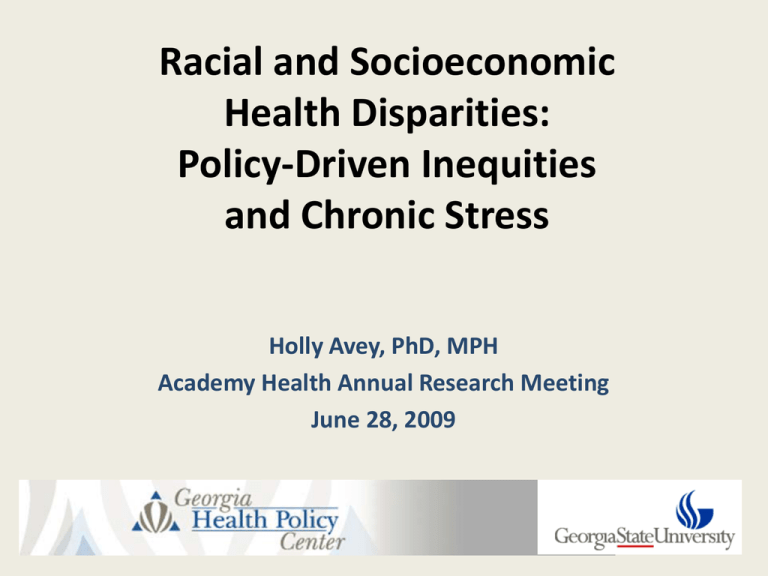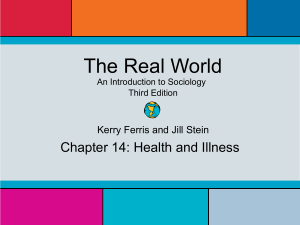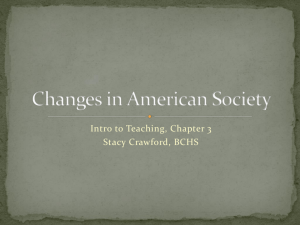Racial and Socioeconomic Health Disparities: Policy-Driven Inequities and Chronic Stress
advertisement

Racial and Socioeconomic Health Disparities: Policy-Driven Inequities and Chronic Stress Holly Avey, PhD, MPH Academy Health Annual Research Meeting June 28, 2009 Research Objectives 1. To investigate the a priori theory that exposure to the chronic stress of structural (policy-driven) inequity affects the psychological appraisal process, creating or exacerbating stress-related illness From Policy-Driven Inequity to Disparities Mechanisms for Stress to Translate into Illness Immediate health effects Fight-or-flight response Interim health effects Chronic illness Allostatic load Increased blood pressure High blood pressure Heart disease Increased heart rate Irregular heart beat Stroke Fats released into blood High cholesterol Increased blood clotting Circulation diverted to major muscle groups Circulation of fats Visceral obesity restricted Blood diverted away from Low birth weight fetus Sugars released into blood Breathing rate increases Glucose intolerance Diabetes Hyperventilation Shortness of breath Asthma Respiratory disease Immune system increases, followed by suppressed immune function Colds Flu Pneumonia Dental cavities Cancer Contract HIV (if exposed) HIV / AIDS Mind becomes more alert, followed by suppressed mental function Lethargy Nervousness Depression Anxiety Mechanisms for Stress to Translate into Illness Immediate health effects Fight-or-flight response Interim health effects Chronic illness Allostatic load Increased blood pressure High blood pressure* Heart disease* Increased heart rate Irregular heart beat Stroke* Fats released into blood High cholesterol Increased blood clotting Circulation diverted to major muscle groups Circulation of fats Visceral obesity* restricted Blood diverted away from Low birth weight* fetus Sugars released into blood Breathing rate increases Glucose intolerance Diabetes* Hyperventilation Shortness of breath Asthma* Respiratory disease* Immune system increases, followed by suppressed immune function Colds Flu* Pneumonia* Dental cavities* Cancer* Contract HIV* (if exposed) HIV / AIDS* Mind becomes more alert, followed by suppressed mental function Lethargy Nervousness Depression* Anxiety* * = illness for which there is a racial and/or socioeconomic health disparity (U.S. Department of Health and Human Services, 2000) Research Objectives 2. To illuminate underlying mechanisms of race and class discrimination, such as social closure and relative deprivation Underlying Mechanisms of Race and Class Discrimination: Social Closure • When social and economic opportunities are restricted for certain groups • Includes restriction of access to: – Employment – Housing – Education – Transportation – Healthcare – Legal representation Underlying Mechanisms of Race and Class Discrimination: Relative Deprivation • When certain groups perceive they are deprived of resources compared to others • Includes: – Corporate welfare – Media and consumerism – Wealth gap – Property taxes Study Design: • Surveys were administered to a convenience sample of 310 low- and middle-SES Blacks and low- and middle-SES Whites recruited from doctor’s offices in a large metropolitan area of the Southeast • A sub-set of each population used the photovoice technique and participated in focus groups Quantitative Data Demographic Variables Age Gender Education Independent Variables Race • Self-report • Proxy for institutionalized racial discrimination Qualitative Data Dependent Variables Stress measures • Life Events • Daily Hassles • Traumatic Events • Perceived Stress Focus Group Questions Things that cause you stress • Photovoice and focus group data • Pile-sorted into groups • Top 3 stressors Control over stressor Stress-Related Illness Relative importance SES • High blood pressure • Self-report, of stressor • High cholesterol poverty threshold • Heart disease Resources to deal & wealth items • Stroke with stressor • Obesity • Proxy for Stressors for • Diabetes institutionalized alternate racial and • Asthma socioeconomic • Cancer income groups discrimination • HIV/AIDS • Depression • Anxiety Analysis • Quantitative data was analyzed using multiple regression • Qualitative photovoice data was analyzed by participants according to photovoice guidelines 1) select pictures 2) contextualize pictures 3) codify pictures • Qualitative focus group data was analyzed using pile sorting and inductive analysis • Quantitative and qualitative data were then triangulated Quantitative Data Stress Scales Qualitative Data Determine sample for qualitative methods Photovoice and Focus Groups Compare sources of stress with scale items Determine if race and/or SES account for a significant portion of variance in stress scores Explore relationship between race, SES and perceived sources of stress Explore context of stress experience Principal Quantitative Findings • Race was not found to have an influence on stress scores or stress-related illnesses • Low-socioeconomic status was associated with • Higher exposure to traumatic events • Higher total stress exposures • Higher levels of perceived stress • Higher perceived stress was associated with higher stress-related illness burden • Especially for hypertension, depression, and anxiety Explanatory Regression Analyses for Variables Predicting Stress Scale Scores β Variable entered Step 1 Age Gender Education SES -.06 -.07 -.10 Age Gender Education SES -.02 .03 -.13* Age Gender Education SES .17** .03 -.20** Age Gender Education SES -.14* -.12* -.19** Age Gender Education SES .07 .01 -.18** *p < .05 ** p <.01 Step 2 R2 Life Events Stress .02 -.10 Daily Hassles Stress .02 -.10 Traumatic Events Stress .07** -.17** Perceived Stress .07** -.14* Total Stress Exposures .04** -.16* Model F ∆R2 1.65 1.83 .01 1.82 1.91 .01 7.88** 7.85** .02** 7.05** 6.52** .01* 4.23** 4.82** .02* Principal Qualitative Findings • Differential exposures and stress appraisals are a result of institutionalized class discrimination which limits social and economic resources for low-SES populations such as: – Housing – Transportation – Legal representation – Physical and behavioral health care Social Closure Prego (LSW): “A lot of the lower class people that don’t make money get the focus on them. When there’s…children with rich families they get abused and their parents do drugs and drink and nobody says anything because they have money so … it’s all about money anymore.” Georgia Girl (LSW): “Working in a small business, the banks will work with them much quicker and help them, because the former company I was working with was just bouncing checks like crazy … $500 and something dollars a month … where if that had been us they would have … taken us to jail for deposit account fraud.” Fred (MSW): “Society structure [is] that if you have more money you can get better help that is going to be more effective for you if you have the insurance. If you don’t have it is so limited.” Relative Deprivation Boom Boom (LSB): “Now us, not having much money … if we get put out, we’re on the streets … if they lose the big place … they can still get an apartment. They’re not going to be put on the street.” Blacky (LSB): “They can get their car fixed with money, even if it breaks down.” Boom Boom(LSB): “Ervin Magic Johnson came out and said he had the AIDS virus, he says he’s clean. I mean he’s over it. How many people are dying from it? Why because they don’t have the money. They don’t have the resources to get the medication to pay for it. … That’s the difference between a lot of money and a little money.” Nissan (LSB): “Power and control.” Conclusions • Results confirmed the a priori theory that low-SES groups are exposed to more stressors and have higher levels of perceived stress and stress-related illness than middle-SES groups • Results did not confirm the same to be true for Blacks when compared to Whites • Historical mechanisms of institutionalized race discrimination may make SES more relevant as a stressor for Blacks today • The policy-driven context of social and economic resources results in perceptions of social closure and relative deprivation for low-SES groups Implications for Policy • Policies that limit social and economic resources or result in inequitable opportunities for low-SES populations can result in social closure and relative deprivation • Such policies and the psychological assessments they trigger may be a root cause of many SES-related health disparities Implications for Policy • Policy egalitarianism* – Equitable education spending and financial aid – Less restrictive TANF support – Support for unions – Equitable transportation expenditures – Housing equity – foreclosure policies Moller S. The state and structural vulnerability: Policy egalitarianism and household income. Research in Social Stratification and Mobility. 2008; 26 (4): 323-340. Thank you! Holly Avey, PhD, MPH Senior Research Associate Georgia Health Policy Center Georgia State University havey@gsu.edu 404-413-0291



